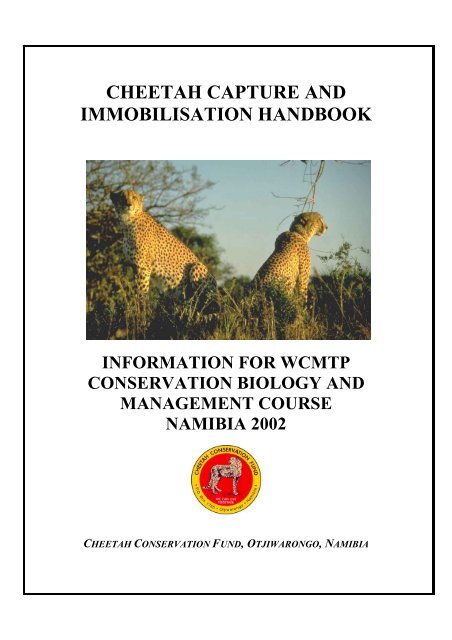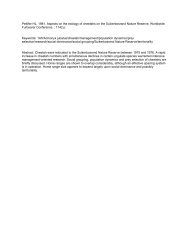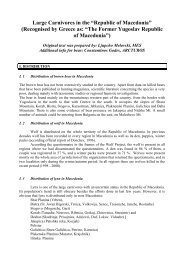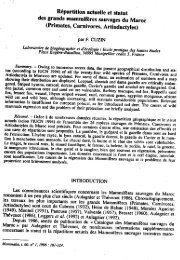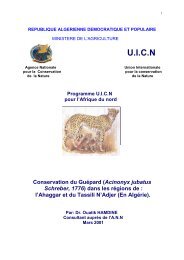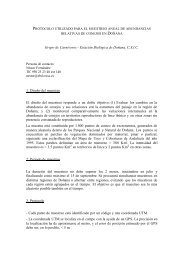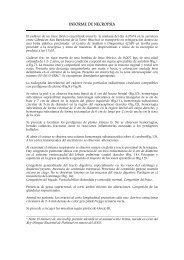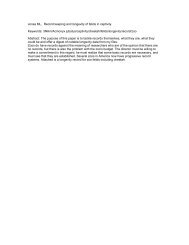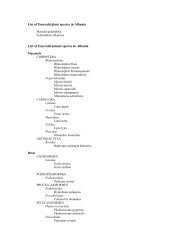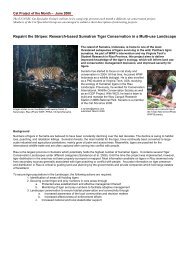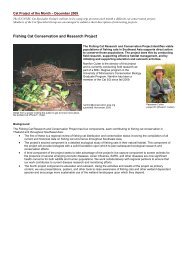cheetah capture and immobilisation handbook - Cat Specialist Group
cheetah capture and immobilisation handbook - Cat Specialist Group
cheetah capture and immobilisation handbook - Cat Specialist Group
You also want an ePaper? Increase the reach of your titles
YUMPU automatically turns print PDFs into web optimized ePapers that Google loves.
CHEETAH CAPTURE AND<br />
IMMOBILISATION HANDBOOK<br />
INFORMATION FOR WCMTP<br />
CONSERVATION BIOLOGY AND<br />
MANAGEMENT COURSE<br />
NAMIBIA 2002<br />
CHEETAH CONSERVATION FUND, OTJIWARONGO, NAMIBIA
Contents<br />
Introduction………………………………………………………………………………..1<br />
Section 1 – Background<br />
(1.1) – Cheetah subspeciation……………………………………………………..1<br />
(1.2) – Current <strong>cheetah</strong> distribution worldwide.…………………………………..2<br />
Section 2 – Physical <strong>capture</strong> of <strong>cheetah</strong>s<br />
(2.1) – Methods of physical <strong>capture</strong>………………………………………………4<br />
(2.2) – Placement of <strong>cheetah</strong> traps………………………………………………...5<br />
(2.3) – <strong>Cat</strong>ching an entire group of <strong>cheetah</strong>s……………………………………...8<br />
(2.4) – H<strong>and</strong>ling <strong>cheetah</strong>s once they have been <strong>capture</strong>d…………………………9<br />
(2.5) – Human safety……………………………………………………………..10<br />
Section 3 – Chemical <strong>capture</strong><br />
(3.1) – Preparations before chemical <strong>capture</strong>……………………………………11<br />
(3.2) – Choosing an anaesthetic agent…………………………………………...11<br />
(3.3) – Dosage……………………………………………………………………12<br />
(3.4) – Administration of the anaesthetic agent………………………………….13<br />
Section 4 - Anaesthesia<br />
(4.1) – After administration of the drug………………………………………….16<br />
(4.2) – Once the <strong>cheetah</strong> is anaesthetised...……………………………………...16<br />
(4.3) – Recovery from anaesthesia……………………………………………….18<br />
(4.4) – Post-anaesthesia………………………………………………………….18<br />
Section 5 – Biomedical examination<br />
(5.1) – Marking the <strong>cheetah</strong> for future identification……………………………21<br />
(5.2) – Collecting biomedical samples…………………………………………..23<br />
(5.3) – Collecting morphometric data……………………………………………26<br />
(5.4) – Observation of abnormalities…………………………………………….30<br />
Appendices<br />
Appendix I – Forms used by CCF for <strong>immobilisation</strong>s<br />
Appendix II – Measurement protocols<br />
Appendix III – Cheetah Husb<strong>and</strong>ry Manual<br />
1
Introduction<br />
The <strong>cheetah</strong> (Acinonyx jubatus) is a highly specialised <strong>and</strong> effective hunter, <strong>and</strong>, as<br />
recently as 1900, had a vast geographic range that spanned Africa, the Middle East <strong>and</strong><br />
across Asia into the Indian subcontinent. During the past century, however, <strong>cheetah</strong>s have<br />
suffered a dramatic decline in both range <strong>and</strong> numbers, <strong>and</strong> while the African <strong>cheetah</strong><br />
still numbers approximately 15 000 individuals, the Asiatic <strong>cheetah</strong> (Acinonyx jubatus<br />
venaticus) has been pushed to the very brink of extinction. This subspecies is now<br />
thought only to exist in Asia, with a small, fragmented population of perhaps 50 animals<br />
remaining in Iran.<br />
Faced with such rapid decline over the past century, it is vital for conservationists across<br />
the globe to work together to formulate effective conservation strategies for the <strong>cheetah</strong>.<br />
Training future researchers is a critical part of this endeavour, <strong>and</strong> particular emphasis<br />
should be placed on capacity-building <strong>and</strong> training within <strong>cheetah</strong> range countries, so that<br />
local scientists are as well-equipped as possible to conduct necessary research <strong>and</strong> make<br />
the best-informed decisions for future conservation work. Some of this research is likely<br />
to involve invasive h<strong>and</strong>ling of <strong>cheetah</strong>s, whether to collect biomedical samples, radiocollar<br />
animals for future tracking, or to remove <strong>cheetah</strong>s from conflict situations. This<br />
h<strong>and</strong>book covers some of the basic techniques used at CCF for such procedures, <strong>and</strong> this<br />
information can be a useful tool for training new scientists. Through such education <strong>and</strong><br />
training, we hope that the most effective strategies can be put in place to attempt to halt<br />
the <strong>cheetah</strong>’s rapid population decline, <strong>and</strong> to conserve a population that is viable in the<br />
longer term.<br />
Section 1 – Background<br />
(1.1) Cheetah subspeciation<br />
Although seven subspecies have been identified, five subspecies are considered valid by<br />
most taxonomists (Smithers 1975), namely:<br />
(a) Acinonyx jubatus venaticus (Griffith, 1821) – the North African/Asiatic <strong>cheetah</strong><br />
Characteristics: Smaller than the East African <strong>cheetah</strong>, with shorter legs, no mane on<br />
nape of neck or belly, small widely spaced spots.<br />
(b) Acinonyx jubatus hecki (Hilzheimer 1913) – the West African <strong>cheetah</strong><br />
Characteristics: Small body size (dainty), pale coat colour.<br />
(c) Acinonyx jubatus soemmeringii (Fitzinger 1855) – the Central African <strong>cheetah</strong><br />
Characteristics: Smaller spots, widely separated, hind feet spotted, pale coat colour.<br />
(d) Acinonyx jubatus raineyii (Heller 1913) – the East African <strong>cheetah</strong><br />
Characteristics: Longer hair similar to A. j. velox (extinct), but shorter, still has neck <strong>and</strong><br />
belly hair, coat colour is paler, fewer spots on back.<br />
2
(e) Acinonyx jubatus jubatus (Schreber 1776) – the Southern African <strong>cheetah</strong>.<br />
Characteristics: Smaller body size, small, well-separated spots<br />
Some taxonomists argue that sub-populations are markedly different <strong>and</strong> have thus<br />
become isolated from other populations with which they are grouped (Nowell & Jackson<br />
1996), but the validity of the existence of sub-species is questionable due to genetic<br />
research which has shown the genetic distance between two subspecies A. j. jubatus <strong>and</strong><br />
A. j. raineyi, is trivial, 10 to 100 times less, for example, than the genetic distance<br />
between human racial groups (O’Brien, et al. 1987). At present though, the genetics of<br />
the central African, North African, West African <strong>and</strong> Asiatic <strong>cheetah</strong>s are yet to be<br />
investigated.<br />
(1.2) Current <strong>cheetah</strong> distribution worldwide<br />
The population of <strong>cheetah</strong> has declined by nearly 90% since the turn of the century<br />
(Marker 1998) at which time the population was estimated at 100,000 individuals found<br />
throughout Asia, India, Africa <strong>and</strong> the Middle East (Myers 1975). Despite widespread<br />
distribution, <strong>cheetah</strong> populations have been greatly reduced. Over the past 50 years<br />
<strong>cheetah</strong> have become extinct in over 13 countries.<br />
Historically, the Asiatic <strong>cheetah</strong> (A. j. venaticus) was widely distributed throughout Asia.<br />
Today this subspecies has suffered a devastating decline of available habitat <strong>and</strong> prey <strong>and</strong><br />
is nearly extinct (Kraus & Marker-Kraus 1992; Nowell & Jackson 1996), with the<br />
remaining population estimated to number fewer than 200 <strong>cheetah</strong>s (Asadi 1998; Marker<br />
1998).<br />
A census of such an elusive species as the <strong>cheetah</strong> is very difficult, particularly since it is<br />
largely diurnal <strong>and</strong> widely roaming. There has not been a comprehensive survey of<br />
African <strong>cheetah</strong> since 1975, when Norman Myers calculated the African population of<br />
<strong>cheetah</strong> to be between 7,000 <strong>and</strong> 23,000 animals in 25 countries. The population of<br />
<strong>cheetah</strong> in Africa had decreased by half since the 1960's (Myers 1975). On the basis of<br />
his research, he estimated that there would be less than 10,000 <strong>cheetah</strong>s by 1980. Current<br />
information about the status of the <strong>cheetah</strong> in many countries, especially countries that<br />
have been engaged in long civil wars, is lacking.<br />
Today, small, fragmented populations of free-ranging <strong>cheetah</strong> inhabit a broad section of<br />
Africa including areas of North Africa, the Sahel, East, <strong>and</strong> southern Africa. From the<br />
information gathered, the current <strong>cheetah</strong> population is estimated at less than 15,000<br />
animals throughout their range, with a low estimate of 9,000 animals <strong>and</strong> an optimistic<br />
estimate of 12,000 animals (Nowell 1996, Marker 1998). Cheetah populations are found<br />
in 29 African <strong>and</strong> 2 Asiatic countries (Marker 1998).<br />
Perhaps for the <strong>cheetah</strong>, though, individual numbers of animals may not be the important<br />
point. The question is, what are the numbers of viable populations still existing? Viable<br />
populations may be found in only half or less of the countries where <strong>cheetah</strong>s still exist.<br />
They include the following countries: Algeria, Angola, Benin, Burkina Faso, Botswana,<br />
3
Cameroon, Central African Republic, Democratic Republic of Congo, Egypt, Ethiopia,<br />
Gambia, Kenya, Libya, Malawi, Mali, Mauritania, Mozambique, Namibia, Niger,<br />
Senegal, Somalia, South Africa, Sudan, Tanzania, Tunisia, Ug<strong>and</strong>a, Western Sahara,<br />
Zambia, Zimbabwe, Iran <strong>and</strong> Pakistan (Marker 1998).<br />
There has been limited information from North or West Africa in the form of personal<br />
correspondence with field researchers <strong>and</strong> the <strong>cheetah</strong>’s future in these areas is<br />
questionable (Plowes 1991; de Smet 1990; Newby 1990; Grettenberger 1987; O’Mopsan<br />
1998). Cheetahs continue to survive in small, pocketed groups in isolated areas<br />
throughout the Sahel. Most of these populations though cannot be considered viable for<br />
long-term survival. Controlling factors are: small populations, restricted habitats with a<br />
limited prey base, conflict with nomadic herder, <strong>and</strong> wars that have supplied guns <strong>and</strong><br />
ammunitions to the populace who poach all forms of wildlife for food <strong>and</strong> profit. The<br />
two remaining strongholds are Kenya <strong>and</strong> Tanzania in East Africa, <strong>and</strong> Namibia,<br />
Botswana <strong>and</strong> Zimbabwe in southern Africa (Marker 1998).<br />
Figure 1: Current world <strong>cheetah</strong> distribution<br />
?<br />
?<br />
?<br />
?<br />
?<br />
?<br />
4
Section 2: Physical <strong>capture</strong> of <strong>cheetah</strong>s<br />
(2.1) Methods of physical <strong>capture</strong><br />
Various methods of physical <strong>capture</strong> are available for the <strong>capture</strong> of carnivores, <strong>and</strong> they<br />
include the use of different traps. The main three types of carnivore traps are as follows:<br />
• Box traps (also known as <strong>capture</strong> cages)<br />
• Gin traps (not recommended)<br />
• Padded leg-hold traps (not recommended for <strong>cheetah</strong> <strong>capture</strong>)<br />
(a) Box-traps<br />
Cheetahs should be <strong>capture</strong>d using box traps, <strong>and</strong> the design of such traps is shown<br />
below. Such traps usually measure around 2m by 0.75m, <strong>and</strong> allow the <strong>capture</strong>d animal<br />
some space to move around. In addition, more than one animal can be held for short<br />
periods in box traps, for instance when several members of a social group are <strong>capture</strong>d,<br />
although the time for such holding should always be kept to a minimum. Box traps<br />
should be built using strong, sturdy material without sharp pieces of metal where a<br />
trapped animal could injure itself. If used properly, the risk of injury using box traps is<br />
relatively low, although it is critical that the guidelines set out for their use should be<br />
strictly followed. Additional advantages of box traps include easy transfer of trapped<br />
<strong>cheetah</strong>s from the trap to a transport crate, while non-target animals <strong>capture</strong>d can be<br />
released easily <strong>and</strong> without harm.<br />
Figure 2: Design of a box-trap<br />
5
(b) Other <strong>capture</strong> techniques<br />
Leg-hold traps, even padded ones, can often cause injury unless they are very<br />
sophisticated, <strong>and</strong> are not recommended as a way of catching <strong>cheetah</strong>s. Gin traps<br />
especially cause serious injury <strong>and</strong> should NEVER be used as a method of <strong>capture</strong>. The<br />
picture below demonstrates the damage that can be caused to animals <strong>capture</strong>d in this<br />
way.<br />
Figure 3: Injury caused by a gin trap<br />
Additionally, while it is possible to <strong>capture</strong> <strong>cheetah</strong>s by physically running them down,<br />
the technique should also NEVER be used, as it is extremely stressful for the <strong>cheetah</strong> <strong>and</strong><br />
the successful <strong>capture</strong> of an entire social group is very unlikely.<br />
(2.2) Placement of <strong>cheetah</strong> traps<br />
A trap just placed at r<strong>and</strong>om out in the bush or desert is unlikely to be effective at<br />
capturing <strong>cheetah</strong>s. For the successful placement of a <strong>cheetah</strong> trap, it is necessary to<br />
underst<strong>and</strong> the ecology <strong>and</strong> behaviour of <strong>cheetah</strong>s in that area.<br />
(a) Use of habitual scent-marking sites<br />
In Namibia, <strong>cheetah</strong>s (particularly adult males) use certain trees as scent-marking<br />
locations, <strong>and</strong> these so-called ‘playtrees’ are effective sites for placing traps, although<br />
they are unlikely to <strong>capture</strong> a representative sample of the <strong>cheetah</strong> population.<br />
6
In other countries, the use of playtrees has not been documented, but local people may<br />
know of areas <strong>and</strong> structures where <strong>cheetah</strong>s frequent <strong>and</strong> use to defaecate <strong>and</strong> scentmark<br />
– for instance, the use of cement block road-signs in Zimbabwe. Such sites are very<br />
good <strong>capture</strong> locations as they have a relatively high visitation rate, <strong>and</strong> the <strong>cheetah</strong>s tend<br />
to have a strong desire to get to the scent-marking site. This drive is used to <strong>capture</strong><br />
<strong>cheetah</strong>s, by blocking off access to the site <strong>and</strong> leaving only one access route, in which a<br />
box-trap is placed. In Namibia, for instance, thorn bushes are cut down <strong>and</strong> packed<br />
around playtrees, with a trap placed as the only way to get to the tree.<br />
Figure 4: Placement of a box-trap by a playtree<br />
(b) Roadways <strong>and</strong> fence-lines<br />
In areas where sites such as playtrees are not known or cannot be used, another potential<br />
<strong>capture</strong> site is along roadways <strong>and</strong> fence-lines. Especially in areas of fairly dense<br />
vegetation, <strong>cheetah</strong>s, as well as other animals, tend to walk along roads <strong>and</strong> tracks. If<br />
such a route is blocked off, for instance by using bushes to create a barrier, a <strong>cheetah</strong> will<br />
often walk through an open gap where a box-trap can be placed. Fence-lines are another<br />
popular route used by <strong>cheetah</strong>s <strong>and</strong> the same technique can be used to <strong>capture</strong> <strong>cheetah</strong>s<br />
along fences. The most effective locations will be in areas where there is some evidence,<br />
for instance by sightings of tracks, that <strong>cheetah</strong>s use those routes relatively regularly.<br />
7
Figure 5: Setting a trap along a road<br />
(c) Waterpoints <strong>and</strong> livestock camps<br />
In arid, open areas where there is little need for <strong>cheetah</strong>s to use roads or tracks, a more<br />
useful site of <strong>capture</strong> may be at waterpoints, whether it is a dam, waterhole or trough.<br />
Box-traps can be set up near waterpoints, ideally in a location that is not too exposed <strong>and</strong><br />
set on the most likely route from the bush to the water.<br />
Livestock camps can occasionally be useful sites for setting <strong>cheetah</strong> traps, especially if an<br />
animal in the area has become a habitual stock-raider. Again, the same principles apply,<br />
with creating a route that seems to provide access to the camp, encouraging the <strong>cheetah</strong> to<br />
take that path, <strong>and</strong> placing a box-trap as the only way of getting to the camp.<br />
(d) The use of camouflage <strong>and</strong> bait<br />
Although traps for many carnivore species must be carefully camouflaged <strong>and</strong> are usually<br />
set with either live or dead bait, in most of the cases outlined above <strong>cheetah</strong>s will enter a<br />
box-trap even if it is very visible <strong>and</strong> contains no bait. That applies most in cases where<br />
the <strong>cheetah</strong> has a strong drive to get to the site in question, for instance a playtree or<br />
sometimes a livestock camp.<br />
The only times where bait may be necessary are when there is no way of blocking off all<br />
potential routes of access for <strong>cheetah</strong>s, for instance around a waterhole. In such cases, a<br />
cage can be placed alongside the set <strong>cheetah</strong> trap, containing an animal such as a young<br />
goat or lamb that will call <strong>and</strong> attract the predator to that spot. If this is done, it is vital<br />
that the animal being used as a lure has adequate shade, food, water <strong>and</strong> bedding, is<br />
checked regularly <strong>and</strong> is not left for too long in the lure cage.<br />
8
Figure 6: Using bait to catch a <strong>cheetah</strong><br />
(2.3) <strong>Cat</strong>ching an entire group of <strong>cheetah</strong>s<br />
Cheetahs are relatively social felids, <strong>and</strong> as such often live in groups, such as a mother<br />
with cubs, newly independent littermate groups or a coalition of adult males. If one<br />
<strong>cheetah</strong> is <strong>capture</strong>d, it is vital to ensure that the entire social group is trapped at the same<br />
time. If this does not happen, cubs still dependent on their mother (<strong>cheetah</strong> cubs are not<br />
independent until 16-18 months old) may starve, while the members of the group that<br />
remain free may struggle to hunt after losing a group member <strong>and</strong> may resort to taking<br />
livestock.<br />
To make sure that the entire group of <strong>cheetah</strong>s is <strong>capture</strong>d, when one <strong>capture</strong> is made<br />
adjacent traps should be set up beside the trapped individual. These traps should be left<br />
open for at least another day <strong>and</strong> night, with other access points to the trapped <strong>cheetah</strong><br />
blocked off, ensuring that the trapped cat has plenty of shade <strong>and</strong> water, as well as some<br />
food if it has been trapped for more than one night.<br />
9
Figure 7: Members of a social group being used to catch other group members<br />
In this way, the <strong>capture</strong>d <strong>cheetah</strong>’s calls should attract social group members <strong>and</strong> they<br />
should subsequently be able to be trapped. Once two <strong>cheetah</strong>s have been <strong>capture</strong>d, the<br />
one <strong>capture</strong>d first can be removed to a holding facility while the procedure is repeated<br />
with the second cat, until it is fairly certain that all members of the social group have<br />
been <strong>capture</strong>d. Some farmers use scat (faeces) from trapped <strong>cheetah</strong>s to try to <strong>capture</strong><br />
other <strong>cheetah</strong>s in the area. It is important to check around the trap sites regularly for signs<br />
such as fresh <strong>cheetah</strong> tracks as an indication of whether there are other <strong>cheetah</strong>s in the<br />
group still free.<br />
(2.4) H<strong>and</strong>ling <strong>cheetah</strong>s once they have been <strong>capture</strong>d<br />
Once the entire social group has been caught, the <strong>cheetah</strong>s must be removed <strong>and</strong> taken to<br />
the holding facility for examination. This is done by transferring the animals from the<br />
box trap into a transport crate <strong>and</strong> the method used will be demonstrated during the<br />
course at CCF. Ideally, the transport crate should be fitted with a squeeze panel to ensure<br />
easy administration of the anaesthetic once the <strong>cheetah</strong> is at the holding facility.<br />
Cheetahs trapped in cages are very easily stressed <strong>and</strong> this should always be at the<br />
forefront of your mind. People should approach the box trap slowly <strong>and</strong> quietly, with<br />
only essential personnel coming up to the trap. All noise should be kept to a minimum,<br />
with no-one talking loudly, approaching closely in vehicles etc. To transfer the <strong>cheetah</strong>,<br />
everyone apart from the person necessary to close the crate door should st<strong>and</strong> back <strong>and</strong><br />
stay at the end furthest from the transport crate, to encourage the <strong>cheetah</strong> into it. The<br />
transport crate should be kept dark, e.g. by covering it with a blanket, <strong>and</strong> should have<br />
no-one st<strong>and</strong>ing around it for the transfer. Most <strong>cheetah</strong>s will move into the crate fairly<br />
easily, although sometimes it takes a little time. Harassing the cat to move quickly by<br />
shouting <strong>and</strong> poking at it is unlikely to help speed things up <strong>and</strong> will just stress the<br />
<strong>cheetah</strong> involved.<br />
10
(2.5) Human safety<br />
Although <strong>cheetah</strong>s will not attack a human in the wild, they are still wild animals <strong>and</strong> as<br />
such can be dangerous when <strong>capture</strong>d or cornered. Because of this, <strong>cheetah</strong>s should<br />
always be given some space when they are confined in small areas, to avoid getting into<br />
dangerous situations. Care should be taken when approaching trapped <strong>cheetah</strong>s, as they<br />
will become very stressed <strong>and</strong> may strike out at the observers. This is particularly<br />
important to be aware of when using traps with vertical bars, as <strong>cheetah</strong>s can get their<br />
legs through the bars <strong>and</strong> can potentially cause quite serious injuries if people get too<br />
close. Keep people around the traps to a minimum, <strong>and</strong> be careful <strong>and</strong> observant at all<br />
times.<br />
Important points regarding physical <strong>capture</strong>: a summary<br />
• Traps should be set ensuring that there is adequate shade <strong>and</strong> water for<br />
<strong>capture</strong>d animals, <strong>and</strong> food must be provided if the animal is held for several<br />
days<br />
• Traps MUST be checked regularly (at least daily, preferably early in the day,<br />
especially in a hot location)<br />
• All possible efforts must be made to <strong>capture</strong> all members of a social group at<br />
the same time<br />
• People <strong>and</strong> domestic animals etc. should be kept away from trapped <strong>cheetah</strong>s<br />
as much as possible.<br />
• Take care not to stress the animal in the trap, <strong>and</strong> be observant about human<br />
safety<br />
11
Section 3 - Chemical <strong>capture</strong><br />
(3.1) Preparations before chemical <strong>capture</strong><br />
If the animal to be immobilised is already in a well-managed captive situation, then it<br />
should ideally be fasted for at 24-48 hours, <strong>and</strong> have no water for the two hours prior to<br />
the administration of the <strong>capture</strong> drugs. Water should not be restricted, however, in<br />
situations where the animal is likely to dehydrate rapidly, e.g. if it is in a trap cage on a<br />
hot day. Water must ALWAYS be removed prior to administering any drugs, however, as<br />
a disorientated animal under the effects of drug administration may drown in any water if<br />
it is left available. If the animal is having to undergo repeated anaesthesia every few days,<br />
for instance for veterinary treatment, then it may be necessary to provide food more<br />
frequently, although a 24-hour fast before anaesthesia is still advisable.<br />
If the <strong>cheetah</strong> is held as one of a group, then it should be separated from other animals<br />
prior to being anaesthetised, as it is at risk of being attacked by them once the drug starts<br />
to take effect.<br />
Before using drugs to immobilise a wild animal, the following factors must be<br />
considered:<br />
• Which anaesthetic agent to use, <strong>and</strong> its properties, effects, hazards <strong>and</strong> legal<br />
regulation for use<br />
• Which method of drug administration is to be used<br />
• Whether the personnel involved have all the equipment <strong>and</strong> expertise necessary to<br />
successfully perform the anaesthesia<br />
(3.2) Choosing an anaesthetic agent<br />
There are numerous agents that can be used, alone or in combination, to immobilise wild<br />
animals, <strong>and</strong> there are several good reference books on the subject to decide which is best<br />
for a particular situation (see The Capture <strong>and</strong> Care Manual, McKenzie 1993). Many<br />
drugs can have adverse effects on <strong>cheetah</strong>s, <strong>and</strong> the drug usually chosen at CCF for<br />
dealing with <strong>cheetah</strong>s is Telazol, which is a 1:1 combination of tiletamine hydrochloride<br />
<strong>and</strong> Zolazepam.<br />
The Telazol used at CCF contains 250mg tiletamine <strong>and</strong> 250mg zolazepam in a glass vial<br />
<strong>and</strong> requires hydration with water before use. The st<strong>and</strong>ard ratio of water to Telazol is<br />
1ml for 100mg, i.e. 5ml of sterile water is added to the 500mg vial for use in <strong>cheetah</strong>s to<br />
give a 100mg/ml solution. The concentration should be clearly marked on the vial in<br />
question to ensure that there is no confusion regarding the dose given.<br />
Telazol is used as it has a wide safety margin (also called a therapeutic index), i.e. the<br />
lethal dose is far higher than that required to achieve effective anaesthesia, <strong>and</strong> a degree<br />
of overdose can be tolerated without severe effects. This is particularly important when<br />
12
dealing with wild animals, as the dose given depends on body weight, which must be<br />
estimated in advance, often without a close examination of the animal in question.<br />
Some anaesthetic agents have a reversal agent that can be administered in the case of an<br />
emergency (e.g. atipamezole reverses the effects of medetomidine), but this is not the<br />
case with Telazol. Although the existence of a reversal agent is an advantage, the wide<br />
safety margin of Telazol means that it is a relatively safe anaesthetic drug to use <strong>and</strong> the<br />
need for such reversal should be low.<br />
Advantages <strong>and</strong> disadvantages of Telazol (Burroughs 1993):<br />
Advantages - Wide therapeutic index<br />
Rapid, smooth induction<br />
Good muscle relaxation<br />
Good pain killing effect<br />
Minimal cardiac <strong>and</strong> respiratory depression<br />
Rapid, smooth recovery<br />
Disadvantages – Excessive salivation<br />
Once powder is rehydrated, it should be used within three days if not<br />
refrigerated, or within one week if kept in a fridge. Because of this, it is<br />
important to label the rehydrated solution with the date of hydration.<br />
No antidote is available<br />
During the many years of using Telazol at CCF, we have never experienced serious<br />
problems with excessive salivation, <strong>and</strong> find Telazol to be effective for up to three weeks<br />
if kept refrigerated, but it is essential for all concerned to be aware of these potential<br />
problems.<br />
Certain drugs available for anaesthesia can be very dangerous for the administrator, <strong>and</strong><br />
care should always be taken when h<strong>and</strong>ling such substances. People who are likely to be<br />
h<strong>and</strong>ling any drugs should ensure in advance that they, <strong>and</strong> their co-workers, are fully<br />
aware of the potential effects of the drugs being used <strong>and</strong> the course of action to be taken<br />
in the event of a spillage or overdose, whether human or animal. In addition, laws<br />
governing the h<strong>and</strong>ling <strong>and</strong> administration of such agents vary between countries <strong>and</strong> it is<br />
the researcher’s responsibility to ensure that such rules are understood <strong>and</strong> followed<br />
properly.<br />
(3.3) Dosage<br />
Dosage depends on the anaesthetic agent used, but Telazol is administered to <strong>cheetah</strong>s<br />
intramuscularly at a dose of 4mg/ml. It is important for researchers to be able to<br />
accurately estimate the weight of <strong>capture</strong>d <strong>cheetah</strong>s, to give the correct dose required for<br />
good anaesthesia. A guide to the average weights of <strong>cheetah</strong>s in different age groups, <strong>and</strong><br />
the dose to administer, is shown below.<br />
13
Table 1: Weights <strong>and</strong> dosage for <strong>cheetah</strong>s of different ages<br />
Age group (years)<br />
Average weight<br />
The dose given should be slightly lower for old animals or those that are dehydrated or in<br />
poor condition. In one rather extreme example, an adult male <strong>cheetah</strong> of about 4 years of<br />
age came in to CCF exceptionally dehydrated, <strong>and</strong> although the usual dose for him would<br />
be around 160mg, only 50mg gave deep anaesthesia for several hours. Alternatively,<br />
procedures that are particularly invasive or painful may require a slightly higher dosage.<br />
It is always important to get another person to double-check the dose being given,<br />
regarding the concentration of the solution, the estimated dose that is appropriate <strong>and</strong> the<br />
volume of solution being drawn up. When drawing up the dose, air should gently be<br />
squeezed out of the syringe to avoid error in measuring the volume. In addition, the<br />
bottle <strong>and</strong> batch number of the drug given should be noted down for future reference in<br />
case of any adverse reaction.<br />
It is important that the entire dose needed is given at the same time, as otherwise the<br />
anaesthesia achieved is of poorer quality, with the <strong>cheetah</strong> taking more time to fall asleep<br />
<strong>and</strong> the effect being lighter.<br />
(3.4) Administration of the anaesthetic agent<br />
Dose of Telazol (mg)<br />
Male Female Male Female Male Female<br />
0 - 6 months 15 13 60 52 0.60 0.52<br />
6 months - 1 year 19 19 76 76 0.76 0.76<br />
1 - 1.5 years 37 30 148 120 1.48 1.20<br />
1.5 - 4 years 42 35 168 140 1.68 1.40<br />
4 - 8 years 46 37 184 148 1.84 1.48<br />
8 - 12 years 46 38 184 152 1.84 1.52<br />
Over 12 years 39 36 156 144 1.56 1.44<br />
Telazol is usually administered intramuscularly, <strong>and</strong> care should be taken to ensure that<br />
the dose is delivered into a muscle, by checking that there is no blood drawn back into the<br />
syringe at the intended injection site. Where darting is being used, the person doing the<br />
darting should have enough experience to be hit a muscle, <strong>and</strong> to make sure that the dart<br />
does not hit areas such as the stomach, spine, or the major nerve running down the flank.<br />
There are three main ways of administering anaesthetic agents to <strong>cheetah</strong>s:<br />
• H<strong>and</strong>-syringe while animal is held in a squeeze crate<br />
• Use of a pole-syringe<br />
• Darting, whether via a blow-dart or by using a dart-gun<br />
14<br />
Volume of 100mg/ml<br />
solution (ml)
(a) H<strong>and</strong>-syringe in a squeeze crate<br />
The usual method employed at CCF is to transfer <strong>cheetah</strong>s straight from the box trap into<br />
a special transport crate fitted with a side squeeze panel, which will be demonstrated at<br />
CCF. The side panel is held securely in place during transit, but once at CCF metal poles<br />
are attached to the panel <strong>and</strong> are used to push the <strong>cheetah</strong> against the side of the crate.<br />
Once this happens, the <strong>cheetah</strong> can be held firmly while a muscle is found for drug<br />
administration, <strong>and</strong> the drug can be injected into the muscle. When doing this, the<br />
plunger on the syringe should be pulled back briefly before injecting the drug, to ensure<br />
that the needle has not entered a vein. Care should be taken to ensure that the <strong>cheetah</strong> is<br />
kept still until delivery of the drug is complete, as if it moves unexpectedly the entire<br />
dose may not be injected, or the researcher may inject themselves instead!<br />
Advantages – Easy to find a good injection site<br />
Administration is straightforward <strong>and</strong> it is easy to see that the <strong>cheetah</strong><br />
has received the entire dose intended<br />
Does not require additional sophisticated <strong>and</strong> expensive equipment<br />
Disadvantages – Can only be used in cases where the <strong>cheetah</strong> can be easily transferred to<br />
a squeeze crate<br />
(b) Using a pole-syringe (‘jab-stick’)<br />
Pole syringes are useful in cases where the animal is in a small, confined area or in a<br />
crate that is not equipped with a squeeze panel. Some expertise is required in<br />
administering injections effectively using a pole syringe, as the increased likelihood of<br />
the animal moving away suddenly means that there is a risk of the needle breaking off<br />
during the process. The injection must be done smoothly <strong>and</strong> quickly, applying<br />
continuous pressure until the entire dose has been injected.<br />
Advantages – Can be used in crates <strong>and</strong> small pens where a squeeze system is<br />
unavailable<br />
Allows drugs to be administered with the h<strong>and</strong>ler some distance from<br />
the animal, lessening both the stress to the animal <strong>and</strong> the risk of injury<br />
to the h<strong>and</strong>ler<br />
Disadvantages – Risk of needle breaking off while the injection is being given<br />
More difficult to spend time locating a good injection site than in a<br />
squeeze crate<br />
(c) Darting<br />
Cheetahs are relatively light <strong>and</strong> slim big cats, so fairly light darts should be used –<br />
further information on the choices of darts <strong>and</strong> delivery systems can be found in many<br />
reference guides, such as the ‘Wildlife Restraint Series 1991’ or ‘The Capture <strong>and</strong> Care<br />
Manual’.<br />
15
Darts can be projected either using a blow-pipe or a dart-gun, <strong>and</strong> we use Telinject<br />
systems at CCF. Blow-pipes are useful when the animal is relatively close, <strong>and</strong> require<br />
less preparation <strong>and</strong> adjustment, while the dart-gun is used at longer distances when more<br />
force is required. At CCF, we use either a blow-pipe or an air-pumped dart gun, both of<br />
which will be demonstrated during the course.<br />
Advantages – Darting can be used where the <strong>cheetah</strong> is free or in a large enclosure<br />
Due to the remote system used, the animal does not have to be caught or<br />
confined, so is subject to less stress<br />
Disadvantages – Requires skill on the part of the operator to hit the animal in a suitable<br />
muscle – risk of injury if darted incorrectly<br />
Difficult to hit an exact spot, especially in windy conditions or over long<br />
distances<br />
Difficult to know if the entire dose has been delivered<br />
Figure 8: Darting a <strong>cheetah</strong> using an air-powered dart-gun<br />
If the <strong>cheetah</strong> being darted is free-ranging, then it is vital to make sure that it is kept track<br />
of following the darting, <strong>and</strong> is not lost in the bush where it could be in danger from other<br />
animals etc.<br />
Important points regarding chemical <strong>capture</strong>: a summary<br />
• All personnel involved should be well-informed regarding the drugs used:<br />
their effects, dangers, legal regulations <strong>and</strong> contra-indications<br />
• Everyone should be well-trained in what to do following drug spillages,<br />
accidental ingestion or overdoses, whether human or animal<br />
• Some drugs can be very hazardous <strong>and</strong> require extra precautions<br />
• Accurate drug delivery requires considerable training <strong>and</strong> expertise<br />
16
Section 4 – Anaesthesia<br />
(4.1) After administration of the drug<br />
After the drug has been administered, everyone should move away from the animal <strong>and</strong><br />
one person should observe quietly from a distance, to check that there are no unexpected<br />
problems. All noise <strong>and</strong> movement around the cat should be kept to an absolute minimum<br />
to ensure a smooth transition into anaesthesia.<br />
The time taken to achieve anaesthesia varies case-by-case, but in most cases the <strong>cheetah</strong><br />
will be lying down 4-6 minutes after Telazol delivery <strong>and</strong> will be anaesthetised after 8-10<br />
minutes. Ideally, the <strong>cheetah</strong> should be left quietly until the drug has taken full effect, to<br />
aid a rapid <strong>and</strong> deep anaesthesia.<br />
Often, <strong>cheetah</strong>s undergoing anaesthesia show some signs after drug delivery including<br />
head bobbing, excessive salivation, scraping the ground with the legs while lying down,<br />
<strong>and</strong> sometimes a resistance to the effects, leading to rapid breathing <strong>and</strong> some agitation.<br />
These signs are a normal part of the process <strong>and</strong>, while they should be monitored, are not<br />
usually a cause for panic – we have found that very few <strong>cheetah</strong>s have problems with<br />
Telazol.<br />
(4.2) Once the <strong>cheetah</strong> is anaesthetised<br />
One of the most critical things to remember is that during a normal <strong>immobilisation</strong>, the<br />
<strong>cheetah</strong> is not under surgical anaesthesia <strong>and</strong> is still to some extent aware of light,<br />
movement, sensation <strong>and</strong> noise. To ensure a smooth process, noise <strong>and</strong> movement around<br />
the cat must be kept to a minimum.<br />
Under the effect of Telazol, the <strong>cheetah</strong>’s eyes remain open <strong>and</strong> the pupils are dilated, so<br />
the eyes must be covered to protect them from bright light. In addition, the blinking<br />
reflex is suppressed, so a bl<strong>and</strong> ophthalmic ointment should be applied to protect the<br />
corneas.<br />
Figure 9: Protecting a <strong>cheetah</strong>’s eyes during anaesthesia<br />
17
At this stage, someone should be appointed to ensure that a suitable recovery area or crate<br />
is available in a quiet location.<br />
(a) Monitoring vital signs<br />
The most critical procedure following anaesthesia is the monitoring of heart rate,<br />
respiration <strong>and</strong> body temperature. Body temperature is often elevated following<br />
<strong>capture</strong>, <strong>and</strong> must be monitored closely as the <strong>cheetah</strong>’s ability to thermoregulate is<br />
hampered under anaesthesia. Normal vital rates for <strong>cheetah</strong>s under anaesthesia should be<br />
in the region of:<br />
Body temperature – 101ºF, 38.5ºC<br />
Heart rate – 120-140 beats per minute<br />
Respiration rate – 15-20 breaths per minute<br />
All three parameters are likely to be elevated at the start of the examination but should<br />
reach these norms fairly quickly. They will become elevated again if the animal is<br />
stressed or subjected to an invasive procedure<br />
The most important thing is to appoint one person to check these signs regularly - at least<br />
every 10 minutes if they appear to be stable around the expected values, <strong>and</strong> more often if<br />
they are fluctuating a lot or are showing extreme values.<br />
(b) Temperature control<br />
Temperature regulation is critical, <strong>and</strong> should be carefully monitored, with action taken<br />
before changes become too extreme.<br />
If the animal is too hot (104ºF or above), ice packs wrapped in towels should be placed<br />
where the legs join the body, fans should be used, <strong>and</strong> alcohol can be used to wipe down<br />
the pads. In addition, cold water should be rubbed into the fur, using cool water on the<br />
head <strong>and</strong> taking particular care to avoid getting water into the airway or ears.<br />
If the animal becomes too cold (99ºF or less), blankets <strong>and</strong> heat pads can be used, <strong>and</strong> if<br />
fluids are being administered, care should be taken that they are warmed before being<br />
delivered.<br />
(c) Dehydration<br />
A simple skin-pinch test over the ribs can be used to test the level of hydration, with the<br />
skin forming a ‘tent’ at the pinch site if the animal is dehydrated. Even if an anaesthetised<br />
<strong>cheetah</strong> is well-hydrated, subcutaneous fluids are routinely administered as the cat will<br />
not have access to water until the following day, <strong>and</strong> it helps to flush the drug out of the<br />
animal’s system more rapidly.<br />
18
If the <strong>cheetah</strong> shows signs of dehydration, an intravenous drip should be administered as<br />
well, <strong>and</strong> this technique will be demonstrated at CCF. Intravenous drips require careful<br />
monitoring to ensure that no air is allowed to enter the vein, that the vein does not<br />
rupture, <strong>and</strong> that the <strong>cheetah</strong> is carefully h<strong>and</strong>led so that the drip-line is not pulled out by<br />
accident.<br />
(4.3) Recovery from anaesthesia<br />
A dose of 160mg Telazol on a healthy, well-hydrated adult <strong>cheetah</strong> weighing around<br />
40kg will give approximately 45 minutes of good anaesthesia, although this differs caseby-case,<br />
depending on the animal’s individual drug tolerance <strong>and</strong> the method of drug<br />
delivery.<br />
Signs of recovery include yawning, growling, twitching of the ears more, movement, <strong>and</strong><br />
providing resistance when attempts are made to move the legs, open the mouth or insert a<br />
thermometer. When these signs begin, there is still some time to calmly transfer the<br />
<strong>cheetah</strong> into the crate or recovery area – it is not an instant recovery. When moving the<br />
<strong>cheetah</strong> at this stage, one person should keep hold of the head, making sure that the throat<br />
is not constricted <strong>and</strong> taking care to avoid the <strong>cheetah</strong> biting at objects or people.<br />
If a recovery crate is being used, the <strong>cheetah</strong> should be placed in the crate with its head<br />
straight, making sure that the throat is not kinked <strong>and</strong> that the airway is clear. The crate<br />
should be kept in a quiet, darkened, cool area, with someone observing the recovery from<br />
a distance. Most <strong>cheetah</strong>s will scratch a little with their legs <strong>and</strong> move around in the crate<br />
while recovering, but this should not be extreme. The recovery must be monitored to<br />
make sure that if the <strong>cheetah</strong> thrashes around, it does not get stuck in a position where the<br />
airway is obstructed. Individual <strong>cheetah</strong>s react in different ways to different drugs, <strong>and</strong> if<br />
the recovery is very violent, vets should be consulted about ways of managing this, e.g.<br />
by giving Valium during recovery, or by using a different drug combination.<br />
(4.4) Post-anaesthesia<br />
Cheetahs must NOT been given access to food or water for at LEAST eight hours after<br />
anaesthesia, <strong>and</strong> ideally should be left without food or water for 12 hours or so. If they<br />
are not fully recovered, <strong>cheetah</strong>s can choke on food or drown while attempting to drink.<br />
Also, they must not be put with any other animals while in the recovery phase (minimum<br />
12 hours after anaesthesia, or while showing any signs of still being affected by the drug)<br />
as they are at risk of being attacked for acting strangely. If the <strong>cheetah</strong> is to be released, it<br />
must be kept in holding until it is fully recovered, <strong>and</strong> then it can be fed, watered <strong>and</strong><br />
released.<br />
19
Important points regarding anaesthesia: a summary<br />
• Everyone must keep noise, movements <strong>and</strong> bright lights to a minimum<br />
around the anaesthetised cat<br />
• The <strong>cheetah</strong>’s eyes should be lubricated with ophthalmic ointment <strong>and</strong> then<br />
kept covered<br />
• Body temperature, heart rate <strong>and</strong> respiration must be taken as soon as<br />
possible <strong>and</strong> be monitored closely throughout the procedure<br />
• Action must be taken to deal with changes in body temperature etc. before<br />
they become critical<br />
• Recovery must be monitored to ensure that the <strong>cheetah</strong> does not get into a<br />
position where it cannot breathe<br />
• Following anaesthesia, food <strong>and</strong> water should be withheld until the animal is<br />
fully recovered.<br />
• The <strong>cheetah</strong> should not be put with other animals or be released until it is<br />
fully recovered<br />
20
Section 5 – Biomedical examination<br />
All <strong>cheetah</strong>s should undergo a thorough biomedical examination, <strong>and</strong> the protocol for this<br />
<strong>and</strong> the data sheets used at CCF will be demonstrated. Each <strong>cheetah</strong> examined is given an<br />
accession (AJU: ‘Acinonyx jubatus’) number to identify it, <strong>and</strong> repeated examinations on<br />
the same cat are recorded as ‘AJU # - 2’, “AJU #-3’ etc. In addition, photographs are<br />
taken of the animal’s coat pattern on the body, face <strong>and</strong> tail for future reference, as shown<br />
below.<br />
Figure 10: Body identification photograph<br />
Figure 11: Face identification photograph<br />
21
Figure 12: Tail identification photograph<br />
There are four main parts to the biomedical examination: marking the <strong>cheetah</strong> for future<br />
identification, collection of biomedical samples, collection of morphometric data <strong>and</strong><br />
observation of abnormalities.<br />
(5.1) Marking the <strong>cheetah</strong> for future identification<br />
Three methods of marking are used at CCF: ear-tagging, transponder insertion, <strong>and</strong>, in<br />
some cases, radio-collaring.<br />
(a) Ear-tagging<br />
All <strong>cheetah</strong>s h<strong>and</strong>led by CCF are ear-tagged, as shown in the picture below. Ear-tags are<br />
cheap <strong>and</strong> easy to use, are visible externally, <strong>and</strong> can be used on <strong>cheetah</strong>s of all ages.<br />
They are subject to being ripped or torn out, however, <strong>and</strong> care must be taken to place<br />
them correctly, so that the edge of the ear is not bunched up but there is not too much<br />
space for objects to snag between the ear <strong>and</strong> the tag.<br />
Figure 13: An ear-tag in place<br />
22
(b) Transponder insertion<br />
Transponders are unique microchips that are inserted subcutaneously. They have the<br />
advantage that they cannot be torn off, <strong>and</strong> can be used on <strong>cheetah</strong>s of any age, but they<br />
are not visible externally <strong>and</strong> are relatively expensive, with a transponder reader needed<br />
too. At CCF, the transponders are inserted beside the spine near the base of the tail, on<br />
the right for males <strong>and</strong> on the left for females, but apparently unmarked <strong>cheetah</strong>s should<br />
be scanned all over the body, as the site of insertion varies between organisations.<br />
Figure 14: Inserting a transponder<br />
(c) Radio-collaring<br />
CCF only radio-collars <strong>cheetah</strong>s that will be released within the core study area <strong>and</strong> can<br />
be tracked during weekly flights. Radio-collars are a highly visible method of marking<br />
<strong>and</strong> provide a lot of useful information regarding movements <strong>and</strong> home ranges, but<br />
cannot be used on young animals that are not yet fully-grown. Care must be taken when<br />
fitting radio-collars to ensure that they are not too tight but are fitted well enough so that<br />
they do not become snagged on branches etc, resulting in them coming off or choking<br />
the animal. One useful guide is that it should be possible to fit three fingers between the<br />
collar <strong>and</strong> the neck when it is fastened.<br />
23
Figure 15: A radio-collared <strong>cheetah</strong> under anaesthesia<br />
(5.2) Collecting biomedical samples<br />
Anaesthetising a <strong>cheetah</strong> provides an invaluable opportunity to collect biomedical<br />
samples that can provide a lot of important information regarding the genetics of the<br />
wild <strong>cheetah</strong> population <strong>and</strong> the prevalence of various diseases. We routinely collect<br />
skin, hair <strong>and</strong> blood samples on <strong>cheetah</strong>s examined, <strong>and</strong> all of these collection<br />
techniques will be demonstrated at CCF.<br />
(a) Collection of hair<br />
The <strong>cheetah</strong>’s hind leg should be lifted, <strong>and</strong> hair should be plucked from the inside thigh.<br />
Care must be taken to remove the entire hair, including the follicle at the base, which is<br />
done by plucking the hair firmly in the opposite direction of growth. The hair should be<br />
placed in a film canister, which should be marked clearly with the animal’s identification<br />
(AJU) number, its sex <strong>and</strong> the date.<br />
(b) Collection of a skin sample<br />
The purpose of this is to obtain viably frozen samples of aseptically prepared skin<br />
biopsies. From CCF, These are frozen <strong>and</strong> transported in vapour-phase liquid nitrogen<br />
carriers to Dr. O’Brien’s lab where they will be treated to establish permanent fibroblast<br />
cell culture lines. These lines will serve as permanent sources of DNA <strong>and</strong> protein<br />
products of the animal’s samples.<br />
The skin sample is collected from the area that has been plucked clean of hair on the<br />
inside thigh. It is important that the area from which the skin is taken is free from hair, so<br />
after plucking the area is closely shaved, using betadine to lubricate the skin. After<br />
shaving, the area must be cleaned intensely using gauze swabs, alternating between<br />
24
swabs soaked in betadine <strong>and</strong> those soaked in methylated spirits (‘meths’). Once the area<br />
is clean, it should be wiped with methylated spirit swabs until there is no trace of the<br />
betadine left.<br />
Just before the sample is taken, a final swab should be made using gauze soaked in<br />
methylated spirits. A few seconds should be allowed for the meths to dry, <strong>and</strong> then a<br />
piece of skin should be lifted gently using forceps, <strong>and</strong> sharp scissors used to cut off a<br />
sample of skin.<br />
The skin sample is then processed as below:<br />
1. Open a tube of biopsy transport medium – wipe the outer surface of the lid with<br />
alcohol first before opening. Drop the piece(s) of skin into the tube, make sure they<br />
are immersed in the fluid <strong>and</strong> cap tightly. Biopsies can be kept several hours up to 1-<br />
2 days in this medium.<br />
2. When ready to proceed, wipe neck of transport tube with alcohol swab before<br />
opening carefully, pour off most of the fluid, open a small sterile petri dish, then<br />
dump the skin pieces(s) with the remaining medium into the dish. Replace lid.<br />
3. Pick up sterilized scissors <strong>and</strong> forceps.<br />
4. Remove lid of dish <strong>and</strong> cut up skin with scissors while holding the forceps. Cut into<br />
the smallest pieces possible (a 6mm biopsy punch should be cut into at least 4 pieces).<br />
5. Have a thawed cryotube of freeze medium ready – label, wipe neck with alcohol<br />
swab, <strong>and</strong> loosen the cap.<br />
6. With forceps, transfer pieces of skin from dish into cryotube – make two tubes if<br />
there is enough skin.<br />
7. Tightly cap cryotube.<br />
8. Label cryotube with: date, skin, sex of animal <strong>and</strong> <strong>cheetah</strong> identification (AJU)<br />
number.<br />
9. Freeze overnight in freezer, then place in liquid nitrogen.<br />
(c) Collection of blood<br />
Blood samples are collected for various biological analyses, including genetic, over-all<br />
health <strong>and</strong> disease studies. A minimum of 25 ml of blood is collected, including samples<br />
of heparin, serum <strong>and</strong> EDTA.<br />
Blood samples can be taken from various sites, but at CCF the preferred site is the<br />
saphenous vein, which runs down the inside of the hind leg. If the hind leg is raised, the<br />
vein can easily be raised by having an assistant put pressure in the groove between the<br />
muscles at the top of the inner thigh, as shown below.<br />
25
Figure 16: Collecting blood from the saphenous vein<br />
Before collecting the blood, the site should be cleaned using gauze swabs soaked in<br />
methylated spirits. Then a Vacutainer needle is inserted into the vein, taking care to<br />
steady the vein so that it does not ‘roll’ <strong>and</strong> make the needle pierce right through the vein.<br />
The Vacutainer needle should be inserted bevel-up <strong>and</strong> running fairly parallel with the<br />
vein. Once the Vacutainer needle has been inserted, at least seven Vacutainer tubes<br />
should be filled from an adult <strong>cheetah</strong> – four red-topped tubes, two green-topped tubes<br />
<strong>and</strong> one purple-topped tube. The green <strong>and</strong> purple tubes contain additives to be mixed<br />
with the blood, so must be rocked gently to combine the contents once they have been<br />
filled. After all tubes have been filled, the pressure on the vein can be stopped <strong>and</strong> a<br />
meths swab held over the collection site for a few seconds after needle removal.<br />
The red-topped tubes contain no additive <strong>and</strong> are used to separate off serum, the green<br />
ones contain sodium heparin <strong>and</strong> are used to give plasma, white blood cells <strong>and</strong> red blood<br />
cells, while the purple ones contain EDTA <strong>and</strong> are used to prepare blood smears.<br />
After collection, blood should be allowed to settle for at least an hour <strong>and</strong> then should be<br />
processed as follows:<br />
Processing green-top tubes for genetic analysis<br />
Purpose: To obtain plasma, white blood cells (“buffy coat”) <strong>and</strong> red blood cells, from<br />
heparinised blood, processed <strong>and</strong> frozen within 24 hours after collection.<br />
1. Centrifuge green tubes at 2200-2500 rpm for 10 minutes. Plasma should be clear<br />
(pink to yellow). If not, spin longer.<br />
2. With disposable transfer pipette remove most of the plasma (do not disturb the “buffy<br />
coat”) <strong>and</strong> fill two 2cc cryotubes <strong>and</strong> put the rest in 4-5cc cryotubes.<br />
26
3. With transfer pipette, reach down through remaining plasma <strong>and</strong> remove the “buffy<br />
coat” (interface between plasma <strong>and</strong> red blood cells containing white cells, you will<br />
be removing some RBCs as well). Pool the buffy coats from all the tubes into “blue<br />
top” tube.<br />
4. Add equal amount of “easy blood” to buffy coats <strong>and</strong> mix gently.<br />
5. Label tube with date, <strong>cheetah</strong> accession number <strong>and</strong> sex of animal.<br />
6. From the bottom of the original tube(s) remove red blood cells with transfer pipette<br />
<strong>and</strong> dispense 1.5-2cc to each of 2 cryotubes. Label <strong>and</strong> freeze upright. (The highest<br />
concentration of red blood cells will be at the bottom of the tube where they have<br />
packed during centrifugation.) Remainder of RBCs may be discarded.<br />
Processing of serum (red-topped tubes)<br />
1. Centrifuge red tops at 2200-2500rpm for 10 minutes.<br />
2. Serum should be clear (pink to yellow). If not, spin longer.<br />
3. With disposable transfer pipette remove serum <strong>and</strong> fill one 1cc <strong>and</strong> two 2cc<br />
cryotubes, transfer remaining serum into 4-5cc cryotubes.<br />
4. Label with date, contents, <strong>cheetah</strong> accession (AJU) number <strong>and</strong> sex of animal.<br />
5. Place in freezer.<br />
Making a blood smear<br />
1. Have 3 clean slides ready.<br />
2. Collect blood from the EDTA (purple top) after it has been rocked gently to ensure<br />
blood is well mixed, using sterile needle <strong>and</strong> syringe.<br />
3. Put a small drop of blood close to the end of a slide. A small drop is important to<br />
prevent the smear from being too thick.<br />
4. Lay the slide down on a flat surface.<br />
5. Take a second slide <strong>and</strong> dip the back of one end into the drop of blood, as shown in<br />
the diagram:<br />
6. Let the drop spread across the back edge of the top slide.<br />
7. Then slowly push the top slide the full length of the bottom slide to spread the drop of<br />
blood over the surface of the bottom slide.<br />
8. Repeat this procedure to made a second blood smear.<br />
9. Allow the slides to air dry.<br />
10. Fix in methanol.<br />
11. Label with date, <strong>cheetah</strong> accession (AJU) number <strong>and</strong> sex of animal.<br />
(5.3) Collecting morphometric data<br />
Various studies have been conducted on <strong>cheetah</strong>s to gain information regarding<br />
morphology, but it is difficult to draw accurate conclusions unless the methods used are<br />
clear <strong>and</strong> st<strong>and</strong>ardised. The CCF protocols are described in detail here, <strong>and</strong> we would<br />
urge other researchers either to follow the same techniques or to state clearly where their<br />
methods have deviated, to ensure that future studies can be compared more meaningfully.<br />
27
This is particularly important with the Asiatic <strong>cheetah</strong>s, as the extent of morphological<br />
differences have not been scientifically described.<br />
(a) Ageing of <strong>cheetah</strong>s<br />
Before collection of morphometric data, it is important to decide on the age of the<br />
<strong>cheetah</strong> being examined. This is done by examination of the weight of the animal, tooth<br />
wear <strong>and</strong> discolouration, gum recession, pelage (coat) condition, body measurements, the<br />
social groupings of animals caught together, <strong>and</strong> reproductive condition. The <strong>cheetah</strong>s<br />
examined at CCF are assigned to one of the following eight age groups using these<br />
indicators:<br />
(1) Young cubs (6 months old or younger)<br />
(2) Large cubs (>6 months – 12 months)<br />
(3) Adolescents (>12 months – 18 months). Cheetahs in these age classes were still<br />
considered to be dependent upon their dam.<br />
Independent <strong>cheetah</strong>s were classified as either:<br />
(4) Newly independent <strong>cheetah</strong>s (>18 months – 30 months)<br />
(5) Young adults (>30 months – 48 months)<br />
(6) Prime adults (>48 months – 96 months)<br />
(7) Old adults (>96 – 144 months) or:<br />
(8) Very old adults (over 144 months).<br />
A guide to placing animals in these categories is given below.<br />
28
Table 2: Factors used to place <strong>cheetah</strong>s into age categories<br />
Age <strong>Cat</strong>egory Age Teeth Haircoat<br />
Approx.<br />
weight<br />
class<br />
(months)<br />
(kg)<br />
Deciduous Leg spots <strong>and</strong> yellow<br />
canines <strong>and</strong> coat colouring<br />
1 Young cubs < 6 mo incisors erupt at develop at 6-7 M=up to 19<br />
28-30 days, weeks, <strong>and</strong> the loss F=up to 18<br />
molars by 45-50 of the mantle starts<br />
days<br />
at 3-4 months<br />
The lower<br />
incisors are lost<br />
at seven months Cheetahs between 6-<br />
old, while adult 12 months old still<br />
2 Large cubs 6 - < 12 teeth start to have long fur on the M=12 - 31<br />
mo come in at around back of the neck, F=12 – 30<br />
eight months, by although it is no<br />
9.5 months old, longer a defined<br />
the last adult ‘mantle’<br />
molars<br />
erupted<br />
have<br />
3<br />
4<br />
5<br />
6<br />
7<br />
8<br />
Adolescents<br />
12 - =144<br />
adults mo<br />
Yellowing <strong>and</strong><br />
tartar, receding Coat beginning to<br />
gum lines, look ragged, poorly F=26 – 48<br />
gingivitis, canine groomed, scarred<br />
tipped, loss of<br />
teeth, esp. incisor<br />
Yellowing <strong>and</strong><br />
tarter, receding<br />
gum lines,<br />
gingivitis, broken<br />
teeth, canines Ragged coat, poorly<br />
severely tipped, groomed, scarred<br />
loss of teeth esp.<br />
incisor<br />
canines<br />
<strong>and</strong><br />
29<br />
Approx.<br />
length<br />
(cm)<br />
M=up to 96<br />
F=up to 92<br />
M=84 -120<br />
F=82 –114<br />
M=110 - 133<br />
F=105 – 125<br />
M=119 - 129<br />
F=116 - 130<br />
M=115 - 140<br />
F=113 – 126<br />
M=118 - 137<br />
F=115 – 126<br />
F=105 – 131<br />
Approx.<br />
chest girth General<br />
(cm)<br />
Eyes, open 7 –<br />
M=up to 54 10 days, cubs<br />
F= up to 54 emerge from den<br />
about 6 weeks<br />
M=42 - 61<br />
F=40 – 57<br />
M=60 - 76<br />
F=56 – 64<br />
M=64 - 71<br />
F=63 - 66<br />
M=64 - 83<br />
F=64 – 69<br />
M=66 - 80<br />
F=63 – 75<br />
F=26 – 48<br />
Lanky<br />
appearance until<br />
8-9 months, then<br />
begin to fill out;<br />
acquire twothirds<br />
of adult<br />
size at 12<br />
months old<br />
Full size but not<br />
filled out, leggy<br />
not in proportion<br />
not at adult<br />
weight, still with<br />
dam<br />
Develop muscle<br />
tone<br />
Full grown,<br />
males not fully<br />
muscled, prime<br />
physical<br />
condition<br />
Fully muscled,<br />
prime physical<br />
condition but<br />
beginning to<br />
show signs of<br />
ageing<br />
Pads becoming<br />
elongated <strong>and</strong><br />
smooth due to<br />
wear, sunken<br />
face; body looks<br />
more thin, loss<br />
of muscle tone<br />
Pads quite<br />
smooth <strong>and</strong><br />
elongated,<br />
sunken face;<br />
body<br />
delicate/frail
(c) Collection of data<br />
Vernier callipers are used to record skull length, skull width, muzzle length, tooth<br />
lengths, <strong>and</strong> foot measurements, <strong>and</strong> allow measurements to be recorded to 0.1cm. All<br />
other measurements aside from body mass are taken using a 200-cm measuring tape, <strong>and</strong><br />
are recorded to the nearest 1.0cm. Leg measurements are taken while the legs were<br />
positioned as if the <strong>cheetah</strong> was taking a normal step. Figure 1 describes the measurement<br />
protocol in more detail.<br />
Body mass is measured at CCF using a stretcher on a hanging scale <strong>and</strong> is recorded to the<br />
nearest kilogram, taking care to adjust the reading on the scale for the weight of the<br />
stretcher.<br />
Figure 17: Weighing an anaesthetised <strong>cheetah</strong><br />
The sheets used at CCF to record data from <strong>cheetah</strong>s are shown in Appendix I. Care must<br />
be taken to fill out EVERY sheet FULLY, with particular care taken to note down the<br />
AJU number of the animal concerned. The diagrams shown in Appendix II <strong>and</strong> the<br />
photographs below show how various measurements are taken.<br />
30
Figure 18: Measurement of head - body length<br />
Figure 19: Measurement of foreleg total length<br />
(5.4) Observation of abnormalities<br />
Cheetahs are known to have an unusually low level of genetic variation, <strong>and</strong> certain<br />
morphological abnormalities have been recorded in both wild <strong>and</strong> captive <strong>cheetah</strong>s that<br />
may have a genetic basis. To aid in underst<strong>and</strong>ing this further, three particular<br />
abnormalities are looked for to determine their level of occurrence in the wild population:<br />
crowded lower incisors, focal palatine erosion <strong>and</strong> kinked tails.<br />
(a) Crowded lower incisors<br />
The normal arrangement for the lower incisors is one straight row, but in some cases the<br />
teeth are crowded together <strong>and</strong> become crooked, sometimes to the extent of being<br />
crowded into two rows instead of one. An example of a <strong>cheetah</strong> exhibiting crowded<br />
lower incisors is shown below.<br />
31
Figure 20: Crowded lower incisors<br />
(b) Focal palatine erosion (FPE)<br />
This is a condition where the first lower molar penetrates the palatine mucosa of the<br />
upper palate. It was first noted in captive <strong>cheetah</strong>s <strong>and</strong> was thought to be linked to a ‘soft’<br />
captive diet, but has since been observed in wild <strong>cheetah</strong>s never held in captivity, so may<br />
have some genetic cause. FPE is characterised by reddening <strong>and</strong> bleeding in a groove in<br />
the upper palate <strong>and</strong> investigation of it will be demonstrated at CCF.<br />
Figure 21: Focal palatine erosion<br />
32
(c) Kinked tails<br />
A distinct kink at the end of the tail has been observed in quite a high proportion of the<br />
<strong>cheetah</strong>s examined by CCF. Again, this abnormality may have a genetic basis as similar<br />
kinked tails have been seen in Florida panthers, a highly endangered subspecies of the<br />
North American puma that also exhibits very low genetic variability. Sometimes the kink<br />
is very obvious, as shown below, <strong>and</strong> in other cases is relatively slight, so every <strong>cheetah</strong>’s<br />
tail should be carefully examined to see if any sign of a kink can be felt.<br />
Figure 22: Kinked tail<br />
(d) Other abnormalities <strong>and</strong> injuries<br />
Although these three abnormalities are the main ones that are examined at CCF, any<br />
other abnormalities or injuries seen in <strong>cheetah</strong>s examined should be investigated <strong>and</strong><br />
documented. One example of an injury seen occasionally in Namibia is damage to the<br />
eyes, which may be a result of penetration from thorns in the thick bush, as shown below.<br />
33
Figure 23: Eye injury seen in <strong>capture</strong>d <strong>cheetah</strong><br />
34


